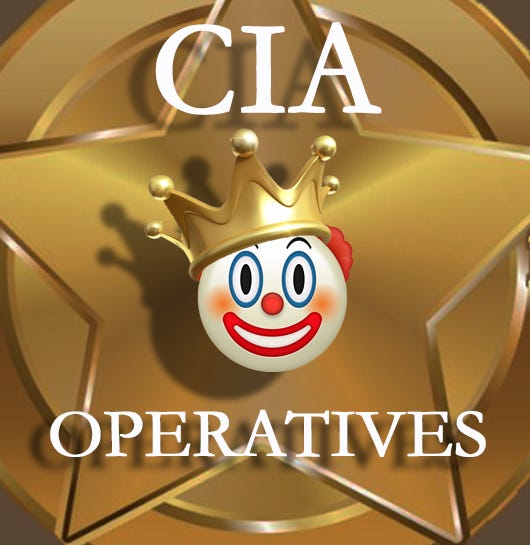[Red Pill Warning]
Tom Braden played a pivotal role in setting up the Central Intelligence Agency's (CIA) cultural playbook during the Cold War. As the Director of the International Organizations Division (IOD) of the CIA from 1951 to 1954, Braden was instrumental in overseeing covert operations aimed at countering Soviet influence and promoting American values through cultural means.
Braden's involvement in the CIA's cultural initiatives began with his leadership in the Congress for Cultural Freedom (CCF), an organization covertly funded by the CIA. Under Braden's direction, the CCF sponsored various cultural events, publications, and intellectual exchanges aimed at demonstrating the superiority of Western culture over Soviet communism. This included supporting abstract expressionism, which was seen as a symbol of artistic freedom and innovation in contrast to the socialist realism promoted by the Soviet Union.
“‘The purpose of the IOD,’ said Braden, ‘was to unite intellectuals against what was being offered in the Soviet Union. The idea that the world would succumb to a kind of Fascist or Stalinist concept of art and literature and music [was] a horrifying prospect. We wanted to unite all the people who were artists, who were writers, who were musicians, and all the people who follow those people, to demonstrate that the West and the United States was devoted to freedom of expression and to intellectual achievement, without any rigid barriers as to what you must write and what you must say and what you must do and what you must paint [Braden’s emphasis], which was what was going on in the Soviet Union. I think we did it damn well.’”[1]
Nelson Rockefeller called abstract expressionism "free enterprise painting," playing perfectly into the CIA’s agenda of countering Soviet art, and Western European art in general. He was a trustee of the Museum of Modern Art from 1932 to 1979 and president from 1946 to 1953. Braden, before he joined the CIA, had worked for Nelson Rockefeller as MoMA’s executive secretary from 1947 to late 1949. Nelson also had previous experience with intelligence work and its intersection with art: "Nelson Rockefeller himself, who had headed up the government’s wartime intelligence agency for Latin America, named the Coordinator of Inter-American Affairs (CIAA). This agency, among other activities, sponsored touring exhibitions of 'contemporary American painting.' Nineteen of these shows were contracted to MoMA." And Braden recalls briefing Nelson in the 1950s.[2]
On MOMA’s board were several men connected or liaisons to the CIA, such Jock Whitney, William Jackson, William Burden, Rene d’Harnoncourt, William Paley (CBS owner), and Joseph Verner Reed (trustee of CIAs money laundering Farfield Foundation) and several others.[3]
Braden in his 1977 article, Birth of the CIA, discusses the enormity of the CIA’s activities and he significantly mentions bought organizations: “…and voluntary organizations had been bought, subsidized, penetrated, or invented as assets for the cold war.”
By the 1960s the CIA had become one world’s largest grant-making institutions:
“By the mid-1960s, the magnitude of the CIA's involvement in the foundation community was staggering … ‘CIA funding was involved in nearly half the grants the non "Big Three" foundations made during this period in the field of international activities.’”[4]
One of the darker legacies of the CIA was that by embedding operatives and/or involving themselves with voluntary foundations, institutions, journals, museums, etc., they harmed the reputation all of them. Institutions tainted by the CIA would not attract good people; rather, they would appeal to nefarious people.
Some have said that the CIA’s cultural project or blueprint is dated, from 70 years ago. But I believe they are still up to their dirty tricks. As recently as 2021, I was introduced to a CIA handler at a gala of a think tank by its founder; he confirmed that the next day when I challenged him about CIA connections. I had been the organization’s artist-in-residence for a few years and immediately told them to remove me from the masthead. Consequently, I had firsthand experience of being used as a respectable front, but it was kind of a relief to find out, as it cleared up so many puzzling interactions involving the organization.
Suffice to say, the money, outreach, and influence of CIA’s abstract expressionist promotion was massive.
It seems to me that Braden and others were using the word “freedom” as an inside joke. They knew that Americans viewed freedom as a right, not to have it infringed, and that Americans knew that millions of people suffered where no rights existed. Calling the Congress for Cultural Freedom a good-sounding name for sharing American values abroad. How amusing to hoodwink the American public by really meaning the opposite: the freedom to do evil, lie, cheat, money launder, torture, poison, and engage in psychological torture—all the things the CIA is known for. It is understandable that the CIA players identified with nihilistic painting, and amused that no one would get the wink. They all knew they were fleecing Americans, had no transparency, and had a charter to use unlimited funds, no oversight, and any devious means imaginable, and they didn’t have to have any positive results. Indeed, so many of their outings ended in disaster. What Braden calls “embarrassments” that happen every four to five years. Though it is interesting that later in his life he called out the CIA’s blunders but didn’t include his pet abstract expressionist project.[5]
The promotion of abstract expressionism had nothing to do with fighting Soviet art; it was a banner of nihilism that gave aesthetic justification the CIA sociopaths and boys with toys. To understand my perspective we have to look into the aesthetics of abstract art.
Franz Kline, Le Gros, 1961. www.moma.org.
Abstract artists like Franz Kline turned abstraction, as an artistic means, into floating abstractions as ends. Instead of organizing elements like trees into a forest or people into a group, they simply neutered the concept of abstraction by eliminating references to reality, consequently rendering the subject of the artwork meaningless.
The few aesthetic values to derive from abstract art are seeing how an artist arranges positive and negative spaces; another is observing how paint is applied; and yet another is witnessing unexpected color choices. But those are small pickings when looked at art as a whole.
Fine art embodies the human condition; it expresses philosophical perspectives and emotions, aiming to provoke thought and introspection about the universe through various mediums like painting and sculpture. On the other hand, decorative arts focus on creating visually pleasing arrangements and functional objects, such as designed furniture and eye-catching wallpapers, prioritizing visual appeal over philosophical and aesthetic depth.
Abstract art embodies neither: it eliminates recognizable content, references to our visual perception, and the human condition, leaving something that is neither fine art nor decoration. Essentially abstract art represents rejecting or denying the existence of inherent meaning or value in reality, leading to a sense of existential denial.
A defining characteristic of psychosis is a detachment from reality. In contrast, the greatest strength of 40,000 years of figurative art is its connection to reality and humanity. Without exaggeration, one could argue that abstract art serves as a metaphor for psychosis and that figurative art is metaphor for human evolution.
It is no surprise of the suicidal proclivities of famous abstract artists, it makes perfect sense when abstract painting is an exercise existential denial—imagine painting 24/7 for decades with no connection to reality. Suicide is the logical end.
“Jackson Pollock was killed in a car crash in 1956, by which time Arshile Gorky had already hanged himself. Franz Kline was to drink himself to death within six years. In 1965, the sculptor David Smith died following a car crash. In 1970, Mark Rothko slashed his veins and bled to death on his studio floor. Some of his friends felt that he killed himself partly because he could not cope with the contradiction of being showered with material rewards for works which ‘howled their opposition to bourgeois materialism.’”[6]
[It is kind of amusing to state: I am not suicidal.]
The CIA, as the largest patron of the arts, managed to destroy the education and recognition of figurative art from the 1950s to present times. Just look at the art departments of Yale and Harvard, and the postmodern (anti-art) content presented in contemporary museums. This relegated authentic and innovative figurative artists to the shadows as controlled opposition. My personal experiences as a fine art major in the 1970s: there was no figurative art taught, no realism, but teachers focused on political and absurd installations. When I was a teacher at Otis College of Art and Design in the 1990s, they did offer figurative art to first-year students, but the next year the fine art majors were thrust into postmodern conceptual classes. And the administration recommended to fine artists that if they wanted to pursue representational art, they should become commercial/graphic art majors. WTF! All of this was due to the flood of CIA influence on worldwide culture.
Two things are going on here the CIA, Tom Braden, and Nelson Rockefeller managed to destroy aesthetic values by massively promoting non-objective anti-art, and on scale that has never happened in the history of humankind. No other culture had promoted demise of art as art. It is actually the greatest evil PsyOp ever, and so subtle its victims never glimpse how they have been had, and worse, they will volunteer to champion the means of mental destruction.
Figurative art starting with prehistoric cave paintings marks the beginning of modern human cognitive abilities It is one of the observable facts we can point to objectively showing human evolution. The CIA was and is destroying one the greatest ways humans evolve and grow, i.e., through figurative art. The consequence was massive BlackOp to destroy the human mind. Of course Braden and cohorts could have just been morons with power, but I like to think when massive evil happens it is due to intentional genius. And that motive would be to eradicate good people, as they are threat to sociopaths.
Transparent ends and means, worthy of each other, is the only way to progress personally and in culturally. Covert and unethical ends and means only lead to failure and destruction psychologically, in reality, and in art. Giving money, power, and “freedom” to sociopaths is a recipe for the destruction of humankind. Nice legacy CIA.
In the face of covert agendas and the erosion of authenticity, let us counter it by individually championing the goodness of humanity and celebration of figurative art.
[1] Saunders, Frances Stonor. The Cultural Cold War: The CIA and the World of Arts and Letters (pp. 82-83). The New Press. Kindle Edition.
[2] Saunders, F.S. Ibid. (p. 218).
[3] Saunders, F.S. Ibid. (p. 221).
[4] Warner, Michael. Hearts and Minds: Three Case Studies of the CIA's Covert Support of American Anti-Communist Groups in the Cold War; 1949-1967 (p. 59). And the Senate Select Committee to Study Governmental Operations with respect to Intelligence Activities, "Final Report: Foreign and Military lntelligence. Book l," 94th Congress, 2d Session 1976. (p. 182).
[5] Braden, Tom. Spies Who Came in from the Cold War, The Washington Monthly, March, 1992, (pp. 18-24).
[6] Saunders, F.S. Ibid. (p. 234).







What an excellent re-cap of modern art history, revealing important background information for us to know. I am so happy you're out there, taking a stand for beauty and for humanity, and for meaningful, reflective art, Michael.
"Without exaggeration, one could argue that abstract art serves as a metaphor for psychosis and that figurative art is a metaphor for human evolution." - Michael defines the difference between separation and oneness. Between bullshit and authenticity. It takes courage to say these things as an artist.